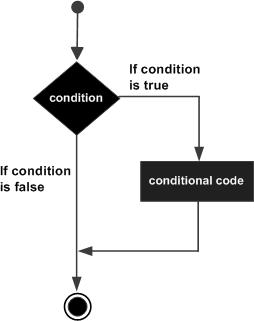
- Perl 基礎
- Perl - 首頁
- Perl - 簡介
- Perl - 環境
- Perl - 語法概述
- Perl - 資料型別
- Perl - 變數
- Perl - 標量
- Perl - 陣列
- Perl - 雜湊表
- Perl - IF...ELSE
- Perl - 迴圈
- Perl - 運算子
- Perl - 日期和時間
- Perl - 子程式
- Perl - 引用
- Perl - 格式
- Perl - 檔案 I/O
- Perl - 目錄
- Perl - 錯誤處理
- Perl - 特殊變數
- Perl - 程式碼規範
- Perl - 正則表示式
- Perl - 傳送電子郵件
- Perl 高階
- Perl - 套接字程式設計
- Perl - 面向物件
- Perl - 資料庫訪問
- Perl - CGI 程式設計
- Perl - 包和模組
- Perl - 程序管理
- Perl - 嵌入式文件
- Perl - 函式引用
- Perl 有用資源
- Perl - 問答
- Perl - 快速指南
- Perl - 有用資源
- Perl - 討論
Perl IF 語句
Perl 的if語句由一個布林表示式和一個或多個語句組成。
語法
Perl 程式語言中if語句的語法如下:
if(boolean_expression) {
# statement(s) will execute if the given condition is true
}
如果布林表示式計算結果為true,則將執行if語句內的程式碼塊。如果布林表示式計算結果為false,則將執行if語句結束後的第一組程式碼(右花括號之後)。
數字 0,字串 '0' 和 "",空列表 () 和 undef 在布林上下文中都為false,所有其他值都為true。使用!或not對真值進行否定將返回一個特殊的假值。
流程圖

示例
#!/usr/local/bin/perl
$a = 10;
# check the boolean condition using if statement
if( $a < 20 ) {
# if condition is true then print the following
printf "a is less than 20\n";
}
print "value of a is : $a\n";
$a = "";
# check the boolean condition using if statement
if( $a ) {
# if condition is true then print the following
printf "a has a true value\n";
}
print "value of a is : $a\n";
第一個 IF 語句使用了小於運算子 (<),它比較兩個運算元,如果第一個運算元小於第二個運算元,則返回 true,否則返回 false。因此,當執行上述程式碼時,將產生以下結果:
a is less than 20 value of a is : 10 value of a is :
perl_conditions.htm
廣告